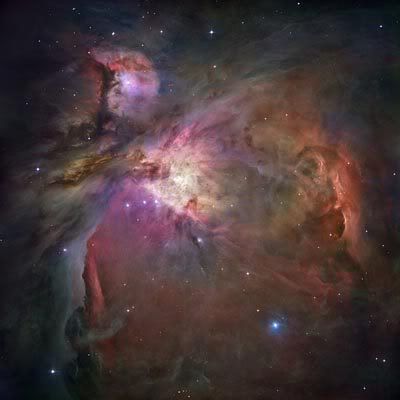
A constellation, which is the head of a constellation family, located in the equatorial region of the sky and belongs certainly to the most famous constellations. It extends from RA=4h 40m to RA=6h 20m and DECL=+23 degrees to DECL=+8 degrees.
In some ways the central part of this constellation reminds on a oblique sand-glass. In wintertime Orion is a magnificent constellation which can easily be found by the the three stars forming a line building the belt of the Hunter. The belt stars point towards Sirius, the brightest star in the constellation of the Larger Dog, Canis Major, situated SE of Orion.
From his belt there hangs a well defined deggar, which is known for one of the most famous nebulas in the sky: The Large Orion Nebula (M42).
Orion lies close enough to the Milky Way to be interesting enough to be swept even with low-power telescopes or binoculars.
Additionally to the data given above there is a skychart to locate the stars and objects.
Stars and objects
The shoulder star alpha Ori, Betelgeuse, is a variable red giant; its brightness varies from 0.4 mag to 1.3 mag with no set period. It belong to the 20 brightest stars in the sky. During it pulsations the diameter of the star varies from 300 to 400 times the diameter of the sun.
The leg of the hunter, beta Ori, Rigel (arab.: the foot), is a blue-white giant of 0.08 mag. This makes it the sixth brightest star in the sky and the brightest in the constellation Orion. With medium sized telescopes it is possible to distinguish the companion of Rigel, a 7th mag star (smaller telescopes may fail to reveal the companion because of the glare of Rigel).
This constellation offers a great number of binaries and multiple stars:
For binoculars and smaller telescopes the following stars are of interest:
Next to it lies theta2 Ori, a duo of a 5th and a 6th mag star.
For resolving the tight double of zeta Ori (Alnitak) in its consisting parts, a bright star of 2.02 mag and a 4th mag companion, scopes with an apertur of at least 75mm and a high resolution are required. Further more there is a wider companion of 10th mag.
Eta Ori is a difficult pair. Scopes with an aperture of 100 mm and higher are necessary to split it into its 4th mag and 5th mag stars.
The constellation Orion became most famous for its nebula. The Messier database has detailed information about The Large Orion Nebula M 42 and M 43, the DeMairan nebula, which is a part of the Orion Nebula.
Around October 21 each year the famous Orionid meteor shower reaches its peak. Coming from the the border to the constellation gemini as much as 20 meteors per hour can be seen. More information about this meteor shower and the Chi Orionids, which are active around the beginning of december can be found in the meteor shower calendar by Gary Kronk. (Readers in the US might use the original site of Gary Kronk).
Mythological Background:
According to greek mythology Orion died being stung by a scorpion. He is set such in the sky that he sets in the west while his slayer, the Scorpius raises in the east.
Followed by his two dogs he is now fighting the bull Taurus.
According to Secrets of the Night Sky (Bob Berman, William Morrow &Co, 1995) the ancient Sumerians saw in this star pattern a sheep. The name Betelgeuse literally means "the armpit"; in case of the Sumerians it meant "the armpit of the sheep."





4 comments:
Hi ~z~,
Where's the Orion gif from? Are there others available for the other constellations?
That little diagram is rich with a variety of catalogs.
peter
Hi Peter,
You know, I downloaded them from the web about a year ago and can't remember from where. Since I didn't bookmark the site I can't give credit. I *think* I have all 88 and will be placing them on the blog through-out the year.
Great! looking forward to the next installment. The sand glass is a fitting description. His dagger, the sands of time.
peter
I've been looking for info on Orion: Part Two and luckily I ran into your blog, it has great info on what I'm looking and is going to be quite useful for the paper I'm working on.
BTW is crazy how many viagra online blogs I manage to dodge in order to get the right site and the right information.
Thanks for the post and have a nice day.
Post a Comment